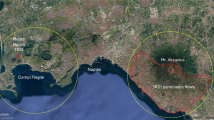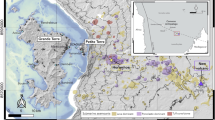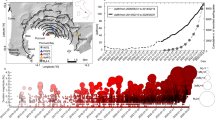Abstract
THE goal of evaluating the risks related to the reactivation of a quiescent volcano requires the reconstructions of the eruptive history of the volcano, the construction therefrom of a behavioural model of the volcano so as to define the 'maximum expected event9 and the subsequent quantitative models allowing reliable simulation of such an event to be set up and hazard and risk maps to be developed. We have followed this approach to infer the size and character of the explosive eruption of Vesuvius to be expected after a 45-year rest period1,2, and we used a numerical model, tested on the recent Mount St Helens eruption and the Vesuvius eruption in AD 79 3,4, to simulate tephra transport and fallout. By combining the fallout model with a statistical analysis of the wind regime and with the density of urban settlement, we were able to assess quantitatively the tephra fallout risk.
This is a preview of subscription content, access via your institution
Access options
Subscribe to this journal
Receive 51 print issues and online access
$199.00 per year
only $3.90 per issue
Buy this article
- Purchase on SpringerLink
- Instant access to full article PDF
Prices may be subject to local taxes which are calculated during checkout
Similar content being viewed by others
References
Santacroce, R. (ed.) Somma-Vesuvius, Rep. No. 114-8 (CNR, Rome 1987).
Santacroce, R. J. Volcanol. geotherm. Res. 17, 237–248 (1973).
Armienti, P., Macedonio, G. & Pareschi, M. T. J. geophys. Res. 93, 6463–6476 (1988).
Macedonio, G., Pareschi, M. T. & Santacroce, R. J. geophys. Res. 93, 14817–14827 (1988).
Macedonio, G., Pareschi, M. T. & Santacroce, R. Proc. Int. Conf. on Volcanoes 487–490 (National Institution for Research Advancement, Tokyo, 1988).
Macedonio, G., Pareschi, M. T. & Santacroce, R. J. Volcanol. geotherm. Res. (in the press).
Sparks, R. S. J. Bull. Volcanol. 48, 3–16 (1986).
Woods, A. W. Bull. Volcanol. 50, 169–193 (1988).
Wilson, L. & Walker, G. P. L. Geophys. J R. astr. Soc. 89, 657–679 (1987).
Cornell, W., Carey, S. & Sigurdsson, H. J. Volcanol. geotherm. Res. 17, 89–109 (1983).
Report of Consultative Meeting of Experts on the Statistical Study of Natural Hazards and their Consequences Doc. SC/WS/500, 1–11 (UNESCO, Paris, 1972).
Author information
Authors and Affiliations
Rights and permissions
About this article
Cite this article
Barberi, F., Macedonio, G., Pareschi, M. et al. Mapping the tephra fallout risk: an example from Vesuvius, Italy. Nature 344, 142–144 (1990). https://doi.org/10.1038/344142a0
Received:
Accepted:
Issue date:
DOI: https://doi.org/10.1038/344142a0
This article is cited by
-
Creating a digital database of tephra fallout distribution and frequency in Japan
Journal of Applied Volcanology (2022)
-
The long and intertwined record of humans and the Campi Flegrei volcano (Italy)
Bulletin of Volcanology (2022)
-
Probabilistic Volcanic Ash Hazard Analysis (PVAHA) I: development of the VAPAH tool for emulating multi-scale volcanic ash fall analysis
Journal of Applied Volcanology (2016)
-
Effects of eruption source parameter variation and meteorological dataset on tephra fallout hazard assessment: example from Vesuvius (Italy)
Journal of Applied Volcanology (2016)
-
Beyond eruptive scenarios: assessing tephra fallout hazard from Neapolitan volcanoes
Scientific Reports (2016)



